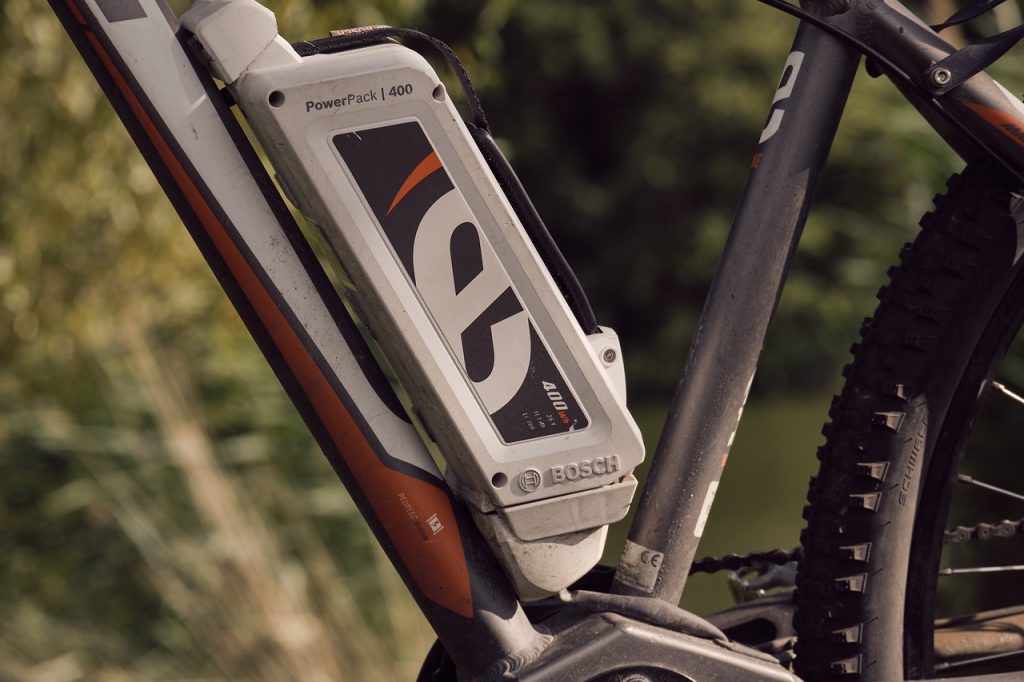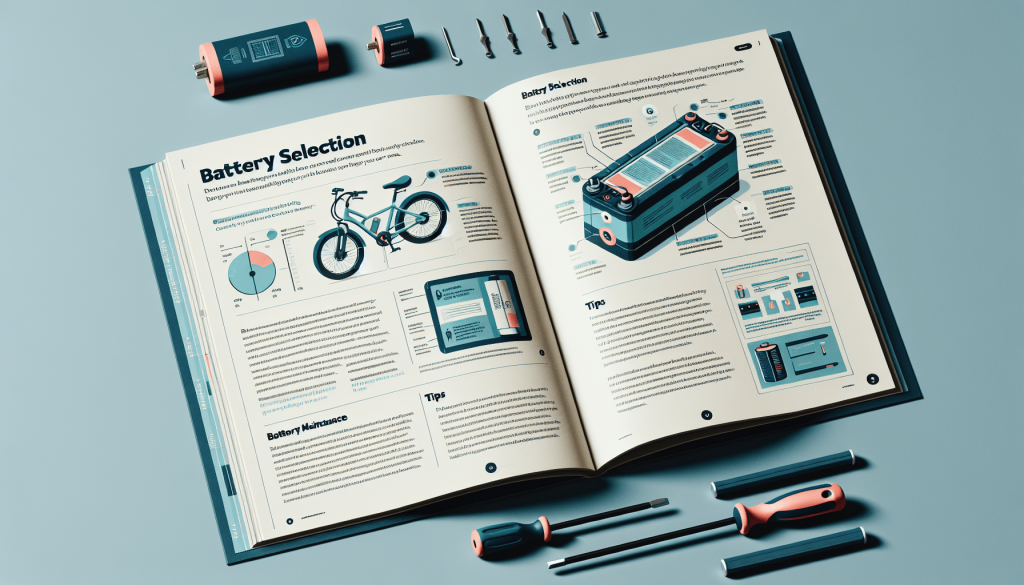How Do I Choose A Battery For My Electric Bike?
Are you in the market for a new battery for your electric bike but feeling overwhelmed by the numerous options available? Look no further! This article is here to help guide you through the process of selecting the perfect battery for your needs. We’ll explore the key factors to consider, such as battery capacity, voltage, and size, and provide you with valuable tips and insights to ensure you make an informed decision. So, whether you’re a seasoned electric bike enthusiast or a newbie looking to make the switch, read on to discover how to choose the ideal battery for your electric bike!

Understanding the Basics
Learn about battery types
When choosing a battery for your electric bike, it’s important to understand the different battery types available. The three main types of batteries used in electric bikes are lead acid batteries, Lithium-ion batteries, and nickel-metal hydride batteries. Each type has its own advantages and disadvantages, so it’s essential to educate yourself on these differences before making a decision.
Consider the voltage
Voltage plays a crucial role in determining the power and efficiency of an electric bike. Understanding voltage ratings and matching the battery voltage to the motor is key to ensuring optimal performance. Different electric bikes may have different voltage requirements, so be sure to check the specifications of your bike and select a battery with the appropriate voltage.
Examine the capacity
The capacity of a battery refers to its ability to store energy, which directly affects the range of your electric bike. Capacity is usually measured in ampere-hours (Ah), and a higher capacity means a longer range. To determine the required capacity for your electric bike, consider factors such as your daily commute distance, terrain, and any additional power needs you may have.
Factors to Consider
Determine your riding style
Your riding style is an important factor to consider when choosing an electric bike battery. If you have a long and demanding daily commute, you may require a battery with a larger capacity and longer range. On the other hand, if you primarily use your electric bike for shorter trips or leisurely rides, a battery with a smaller capacity may suffice.
Evaluate the range
The range of an electric bike refers to the distance it can travel on a single charge. To evaluate the range you need, consider factors such as your daily commute distance and the terrain you’ll be riding on. If you have a longer commute or frequently ride on hilly terrains, you may require a battery with a larger capacity and longer range.
Weight and size considerations
The weight and size of the battery can impact the overall performance and handling of your electric bike. Consider the available space on your bike for battery placement and choose a battery that fits comfortably. Additionally, evaluate the weight-to-power ratio of the battery to ensure it doesn’t add unnecessary weight to your bike, affecting its maneuverability.
Check for compatibility
Ensuring compatibility between the battery and your electric bike is crucial for optimal performance and safety. Check the specifications and requirements of your bike and choose a battery that matches those. Additionally, consider battery mounting options to ensure easy and secure installation.
Consider budget
Budget is an important consideration when choosing an electric bike battery. Set a budget and evaluate the cost versus the quality of different batteries. While it may be tempting to opt for a cheaper battery, it’s important to balance affordability with reliability and longevity. Investing in a higher-quality battery may save you money in the long run by providing better performance and longer lifespan.
Battery Types
Lead Acid Batteries
Lead acid batteries are the oldest and most common type of battery used in electric bikes. They offer a relatively low cost and have a long lifespan when properly maintained. However, lead acid batteries are heavy, take longer to charge, and have a lower energy density compared to other battery types. They are best suited for riders on a tight budget or those who prioritize longevity over weight and performance.
Lithium-ion Batteries
Lithium-ion batteries are the most popular and widely used type of battery in electric bikes. They have a high energy density, allowing for a lighter and more compact design. Lithium-ion batteries also have a longer lifespan and shorter charging time compared to lead acid batteries. However, they tend to be more expensive and require proper care to prevent damage or reduce their lifespan.
Nickel-Metal Hydride Batteries
Nickel-metal hydride (NiMH) batteries are a less common option for electric bike batteries. They offer a balance between the cost of lead acid batteries and the performance of lithium-ion batteries. NiMH batteries have a higher energy density and longer lifespan than lead acid batteries but are generally more affordable than lithium-ion batteries. However, they are less efficient and have a lower energy density compared to lithium-ion batteries.
Voltage Selection
Understanding voltage ratings
Voltage ratings indicate the electrical potential difference between the positive and negative terminals of a battery. It is essential to understand the voltage requirements of your electric bike to ensure compatibility and optimal performance. Higher voltage batteries can provide more power and acceleration, but they may also be heavier and more expensive.
Matching the battery voltage to the motor
To ensure compatibility, it’s crucial to match the battery voltage to the motor of your electric bike. Check the specifications of your bike and select a battery with a voltage that matches or is compatible with your motor. Using a battery with a higher voltage than the motor requires may damage the motor or reduce battery lifespan, while using a battery with a lower voltage may result in reduced performance.

Capacity Considerations
Understanding ampere-hour (Ah)
Ampere-hour (Ah) is the unit used to measure the capacity of a battery. It represents the amount of electric charge a battery can deliver in one hour. The higher the Ah rating, the longer the battery can power your electric bike. Understanding the concept of Ah is important when determining the required capacity for your electric bike.
Determining the required capacity
To determine the required capacity for your electric bike battery, consider factors such as your daily commute distance, terrain, and any additional power needs. A larger capacity battery is recommended for longer commutes or riding on hilly terrains, while a smaller capacity battery may be sufficient for shorter trips or leisurely rides. Strike a balance between capacity and weight to ensure optimal performance and range.
Riding Style Assessment
Determine your daily commute distance
Knowing your daily commute distance helps determine the range you’ll need from your electric bike battery. Measure the distance you typically cover during your daily rides, including any detours or errands. This information will guide you in selecting a battery with the appropriate range to ensure you won’t run out of power during your commutes.
Evaluate your terrain
Consider the type of terrain you’ll be riding on regularly. If you frequently encounter hilly or challenging landscapes, you may need a battery with a larger capacity and more power. On the other hand, if your rides mainly consist of flat or smooth terrains, a battery with a smaller capacity may suffice. Match the battery’s power output with the demands of your typical riding terrain.
Consider extra power needs
Take into account any additional power needs you may have. If you plan to carry heavy loads or use accessories such as lights or bike racks, factor in the power consumption of these extras. It may be necessary to choose a battery with a higher capacity to accommodate these additional power requirements. Assess your power needs to ensure you have sufficient power for all your riding activities.

Range Evaluation
Assess average battery range
To gauge the range you’ll need from your electric bike battery, evaluate the average distance you typically cover during your rides. Consider both your daily commute distance and any additional rides you may take. While it’s always good to have some extra range for unexpected detours or longer rides, selecting a battery with a range that comfortably covers your routine rides is advisable.
Consider external factors
Keep in mind that external factors can affect the range of your electric bike battery. Factors such as wind resistance, temperature, tire pressure, and riding style can impact the battery’s performance and energy efficiency. While it’s difficult to account for all these factors accurately, understanding their potential effects can help you make a more informed decision when choosing a battery.
Weight and Size Considerations
Determine the available space on your bike
Before selecting a battery, assess the available space on your electric bike for battery placement. Measure the dimensions of the designated battery location and ensure that the battery you choose will fit comfortably. Consider the type and design of your bike frame, as it may affect the placement options and potential limitations for battery size and weight.
Evaluate the weight-to-power ratio
The weight-to-power ratio of your electric bike battery can significantly impact its performance and handling. A battery that is too heavy may compromise the overall maneuverability and balance of your bike. Consider the weight of the battery in relation to its power output and choose a battery that strikes a balance between providing sufficient power and maintaining a manageable weight.

Compatibility Check
Ensure compatibility with your electric bike
Compatibility is crucial when choosing a battery for your electric bike. Check the specifications and requirements of your bike, including the voltage and mounting options. Ensure that the battery you select is compatible with your bike’s motor, electrical system, and other components. Using an incompatible battery may lead to performance issues, electrical problems, or even damage to your electric bike.
Check battery mounting options
Different electric bikes may have specific battery mounting options, such as frame-mounted or rack-mounted batteries. Consider the mounting options available on your bike and choose a battery that can be easily and securely installed. Ensure that the battery’s mounting mechanism aligns with your bike’s mounting points to prevent any compatibility issues or the need for additional modifications.
Budget Constraints
Set a budget
Setting a budget is an important part of the decision-making process when choosing an electric bike battery. Determine the maximum amount you are willing to spend on a battery and stick to that budget. While it may be tempting to opt for the cheapest option available, remember that the battery is a critical component of your electric bike, and investing in a higher-quality battery may provide better performance and longevity.
Evaluate cost vs. quality
When considering the cost of a battery, also evaluate its quality and performance. Cheaper batteries may save you money upfront, but they may have shorter lifespans, reduced capacity, or inconsistent performance. Evaluate the reputation and reviews of different battery brands to ensure you are getting a reliable and high-quality product within your budget. A battery that offers a good balance between cost and quality is generally the best choice.






